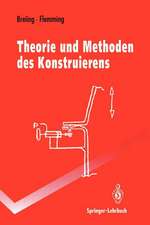The Praxis of Product Design in Collaboration with Engineering
Autor Wayne C. Chungen Limba Engleză Hardback – 16 aug 2018
Case studies include design and engineering development and production of an 8 Tesla MRI, biomedical projects, medical devices, and consumer products. Other cases with Ford Motor Company and Cognizant Technologies illustrate how using a human-centered design process can shift the business paradigm for new products, services, systems, and social innovations. Each story shows different and distinct aspects that span classic design and engineering problem solving to generative contextual processes which lead to innovative solutions.
- Describes a studio-based product development pedagogy so readers can understand through past examples how to operationalize their own design, engineering, and innovation processes;
- Provides specific stories that showcase details of the project work, the contextual insights, and proposed solutions as a result of applying tangible visualizations, collaborative work methods, and framing and reframing of the problem;
- Uses case studies to demonstrate how to use divergent and convergent design thinking and actions from multiple stages of the design process so this can lead to critical team integration and new contextual insights.
| Toate formatele și edițiile | Preț | Express |
|---|---|---|
| Paperback (1) | 575.77 lei 6-8 săpt. | |
| Springer International Publishing – 8 feb 2019 | 575.77 lei 6-8 săpt. | |
| Hardback (1) | 724.80 lei 6-8 săpt. | |
| Springer International Publishing – 16 aug 2018 | 724.80 lei 6-8 săpt. |
Preț: 724.80 lei
Preț vechi: 883.91 lei
-18% Nou
Puncte Express: 1087
Preț estimativ în valută:
138.73€ • 150.75$ • 116.61£
138.73€ • 150.75$ • 116.61£
Carte tipărită la comandă
Livrare economică 21 aprilie-05 mai
Preluare comenzi: 021 569.72.76
Specificații
ISBN-13: 9783319955001
ISBN-10: 3319955004
Pagini: 110
Ilustrații: XII, 116 p. 60 illus., 48 illus. in color.
Dimensiuni: 155 x 235 mm
Greutate: 0.36 kg
Ediția:1st ed. 2019
Editura: Springer International Publishing
Colecția Springer
Locul publicării:Cham, Switzerland
ISBN-10: 3319955004
Pagini: 110
Ilustrații: XII, 116 p. 60 illus., 48 illus. in color.
Dimensiuni: 155 x 235 mm
Greutate: 0.36 kg
Ediția:1st ed. 2019
Editura: Springer International Publishing
Colecția Springer
Locul publicării:Cham, Switzerland
Cuprins
Chapter1: Vision and Tensions that Elevate Product Design Development.- Chapter2: Mindset and Modes of Design Studio Education.- Chapter3: The Praxis of Design: Framing, Making, Doing, and Defining.- Chapter4: Methods for Building Future States: Framing and Re-Framing.- Chapter5: Enabling D/design Through Curriculum, Collaboration, and Cognition.- Chapter6: Defining in Different Ways to Shifts Paradigm.
Notă biografică
Wayne C. Chung is an Associate Professor and Product Design Program Chair in the School of Design, Carnegie Mellon University. Professor Chung’s research and work span medical systems and devices, robot designs, and consumer and industrial products.
Textul de pe ultima copertă
This book reveals how a generative design process capitalizes on understanding humans in context to deliver appropriate innovation. A repertoire of design actions and output allows designers to work dynamically in order to create a cascade of new ideas and insights. The Design Matrix, a visual team tool, provides a prescriptive and descriptive guide enabling a range of users to work through a problem and also reflect on past decisions. Several case studies from prior industry collaborative projects show the complexities and tensions that can be tackled through the design process and matrix.
Case studies include design and engineering development and production of an 8 Tesla MRI, biomedical projects, medical devices, and consumer products. Other cases with Ford Motor Company and Cognizant Technologies illustrate how using a human-centered design process can shift the business paradigm for new products, services, systems, and social innovations. Each story shows different and distinct aspects that span classic design and engineering problem solving to generative contextual processes which lead to innovative solutions.
Case studies include design and engineering development and production of an 8 Tesla MRI, biomedical projects, medical devices, and consumer products. Other cases with Ford Motor Company and Cognizant Technologies illustrate how using a human-centered design process can shift the business paradigm for new products, services, systems, and social innovations. Each story shows different and distinct aspects that span classic design and engineering problem solving to generative contextual processes which lead to innovative solutions.
- Describes a studio-based product development pedagogy so readers can understand through past examples how to operationalize their own design, engineering, and innovation processes;
- Provides specific stories that showcase details of the project work, the contextual insights, and proposed solutions as a result of applying tangible visualizations, collaborative work methods, and framing and reframing of the problem;
- Uses case studies to demonstrate how to use divergent and convergent design thinking and actions from multiple stages of the design process so this can lead to critical team integration and new contextual insights.
Caracteristici
Describes a studio-based product development pedagogy so readers can understand through past examples how to operationalize their own design, engineering, and innovation processes Provides specific stories that showcase details of the project work, the contextual insights, and proposed solutions as a result of applying tangible visualizations, collaborative work methods, and framing and reframing of the problem Uses case studies to demonstrate how to use divergent and convergent design thinking and actions from multiple stages of the design process so this can lead to critical team integration and new contextual insights



























